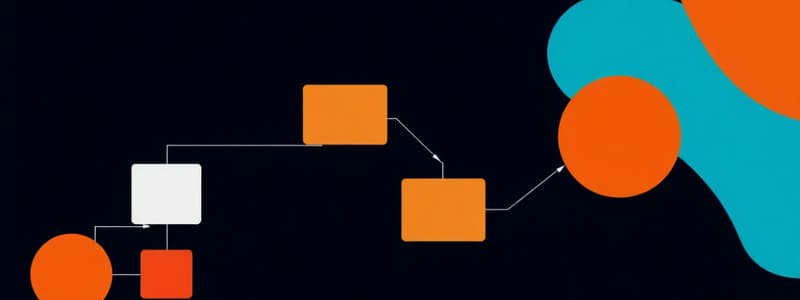Podcast
Questions and Answers
Which of the following best describes the primary focus of a sequence diagram?
Which of the following best describes the primary focus of a sequence diagram?
- The static relationships between classes in a system.
- The user interface layout and design of a system.
- The data flow and transformations within a system.
- The time-ordered interactions between objects in a system. (correct)
In a sequence diagram, what does an activation box on a lifeline represent?
In a sequence diagram, what does an activation box on a lifeline represent?
- The initial state of the object when the diagram starts.
- The physical location where the object's code is stored.
- The time an object is waiting for input from the user.
- The period during which an object is performing an operation. (correct)
What is the significance of the vertical axis in a sequence diagram?
What is the significance of the vertical axis in a sequence diagram?
- Shows the progression of time during the interaction. (correct)
- Represents the different objects or systems involved in the interaction.
- Indicates the level of importance of each message.
- Displays the amount of data being transferred between objects.
Consider a scenario where object A calls a method on object B, and object B returns a value to object A. How would this interaction be represented in a sequence diagram?
Consider a scenario where object A calls a method on object B, and object B returns a value to object A. How would this interaction be represented in a sequence diagram?
In a sequence diagram, what notation is used to indicate the instantiation of a new object?
In a sequence diagram, what notation is used to indicate the instantiation of a new object?
How is the end of an object's lifecycle (destruction) typically represented in a sequence diagram?
How is the end of an object's lifecycle (destruction) typically represented in a sequence diagram?
When should you use a sequence diagram over other types of UML diagrams?
When should you use a sequence diagram over other types of UML diagrams?
What does the direction of a solid arrow in a sequence diagram signify?
What does the direction of a solid arrow in a sequence diagram signify?
In a sequence diagram, what does a U-shaped arrow pointing back to an object typically represent?
In a sequence diagram, what does a U-shaped arrow pointing back to an object typically represent?
What is the key difference between a synchronous and an asynchronous message in a sequence diagram?
What is the key difference between a synchronous and an asynchronous message in a sequence diagram?
In the context of sequence diagrams, what does a 'guard' refer to?
In the context of sequence diagrams, what does a 'guard' refer to?
Which of the following is a characteristic of an asynchronous message?
Which of the following is a characteristic of an asynchronous message?
How are sequence diagrams typically derived, according to the content?
How are sequence diagrams typically derived, according to the content?
In the context of developing sequence diagrams, when are additional objects typically identified?
In the context of developing sequence diagrams, when are additional objects typically identified?
What is a key consideration when deciding whether to create a sequence diagram for every possible scenario of a use case?
What is a key consideration when deciding whether to create a sequence diagram for every possible scenario of a use case?
In the self-service machine example, which object is responsible for delivering the selected product to the customer?
In the self-service machine example, which object is responsible for delivering the selected product to the customer?
Flashcards
Sequence Diagram
Sequence Diagram
A type of interaction diagram that models interactions between objects in a system over time, emphasizing the sequence of messages.
Actor (in Sequence Diagram)
Actor (in Sequence Diagram)
Entities interacting with the system, typically outside its scope.
Objects (in Sequence Diagram)
Objects (in Sequence Diagram)
Specific instances of classes that participate in the execution of an operation or use case.
Lifeline (in Sequence Diagram)
Lifeline (in Sequence Diagram)
Signup and view all the flashcards
Activations
Activations
Signup and view all the flashcards
Messages (in Sequence Diagram)
Messages (in Sequence Diagram)
Signup and view all the flashcards
Create (Sequence Diagram)
Create (Sequence Diagram)
Signup and view all the flashcards
Destroy (Sequence Diagram)
Destroy (Sequence Diagram)
Signup and view all the flashcards
Self-Message (Self-Call)
Self-Message (Self-Call)
Signup and view all the flashcards
Synchronous Message
Synchronous Message
Signup and view all the flashcards
Asynchronous Message
Asynchronous Message
Signup and view all the flashcards
Sequence Diagrams from Use Cases
Sequence Diagrams from Use Cases
Signup and view all the flashcards
Object Identification in Diagrams
Object Identification in Diagrams
Signup and view all the flashcards
Multiple Scenarios in Sequence Diagrams
Multiple Scenarios in Sequence Diagrams
Signup and view all the flashcards
Self-Service Machine Example
Self-Service Machine Example
Signup and view all the flashcards
Guarded Message
Guarded Message
Signup and view all the flashcards
Study Notes
- The session focuses on Software Modelling (Part 2), specifically on building usable software during 2024-2025.
Sequence Diagrams: Key Points
- Sequence diagrams model interactions between objects or components in a system over time.
- Sequence diagrams focus on the time ordering of messages.
- These diagrams demonstrate object behavior in a use case by describing the objects and messages exchanged, addressing "what" and "when".
- Diagrams are read from left to right and top to bottom, showing object interactions in time sequence.
Sequence Diagram Notation
- Actor - A type of role that interacts with the system and objects, but is outside the system's scope.
- Object - An instance of a class, created and used in the execution of an operation within a use case.
- Lifeline - Represents an individual participant in the interaction over time using vertical dashed lines.
- Activation - Indicates the period during which an element is performing an operation, shown as narrow rectangles on the lifeline.
- Messages - Communications between objects, including method calls, returns, and self-messages, depicted as arrows.
- Horizontal Axis - Represents the objects or participants.
- Vertical Axis - Represents progression of time.
Basic Sequence Diagram Flow
- One object sends a message to another.
- Messages continue to pass between objects until the initial object receives a final message.
Messages Detail
- A solid arrow originates from the object making the method call, pointing towards the object where the method is implemented.
- A dashed arrow denotes return values.
Creation, Destruction, and Duration
- Create - Represents the instantiation of its target lifeline.
- Destroy - Denotes the end of an object's useful life.
- Duration - Shows the time between two-time instants for a message invocation.
Nested Activation
- Self-Message- When an object sends a message to itself.
- Depicted as a U-shaped arrow pointing back to itself.
- This often represents one method calling another within the same object, or a recursive call.
Synchronous and Asynchronous Calls
- Synchronous Message - Requires the sender wait until the message is processed.
- Indicated by a filled arrowhead.
- Asynchronous Message - Allows the sender to continue processing without waiting for a response.
- Normally indicated by stick or half stick arrowhead.
- EX - A bank customer could apply for a credit card and can receive banking information, or request money while waiting for the application.
Asynchronous Message - Expanded
- Asynchronous messages are sent from an object that does not wait for a response from the receiver.
Use Case Integration
- Sequence diagrams are derived from use cases - the diagram always has a sender and a receiver.
- Objects/classes are identified during object modeling
- Additional objects emerge from dynamic modeling during the process.
Conditional Behavior and Iterations
- Use cases include many scenarios, showing alternatives and iterations.
Self-Service Machine Scenario
- A customer inserts money.
- Selects a product.
- Money travels to the register.
- The register checks product availability.
- The register updates its cash reserve.
- The register delivers the product.
- Relevant objects include the interface, the money register, and the dispenser.
Instance Sequence Diagram
- Scenario - Customer inserts input, selects product, sends input, and then delivers product.
Interaction Frames
- Messages can be conditional.
- These messages are only sent if their respective conditions are met at the time they are called.
Interaction Frames: ALT
- ALT - Alternative envelopes show if statements.
- Only the condition evaluates to TRUE will is executed.
Interaction Frames: OPT
- OPT - Optional envelopes are if statements which do not have an else statement.
- The fragment executes only if the supplied condition is TRUE.
- Equivalent to an alt with one trace.
Interaction Frames: Loop
- Loop - Envelopes show for/while loops.
- Defines conditions that show for/while loops are active for the respective time.
Summary of Interaction Frame Operators
| Operator | Meaning |
|---|---|
| alt | Alternative; only the frame with a true guard executes. |
| opt | Optional; executes only if the guard is true. |
| par | Parallel; frames execute in parallel. |
| loop | Frame executes multiple times; the guard indicates how many repetitions. |
| region | Critical region; only one thread executes at a time. |
| neg | Negative; shows an invalid interaction. |
| ref | Reference; refers to another sequence diagram. |
| sd | Sequence Diagram; surrounds the whole diagram and is optional. |
Library System Example
- Before a sequence diagram begins, a
main()method is needed to commence it.
Developing Diagrams: Step 1 - Identify the Scenario
- Use Case - Reserve Book
- Actor - Library Member
- Precondition - The user must be logged in
Library Steps - Main Flow
- The member searches for a book in the catalog.
- The system checks book availability - if available, the member can reserve it, and if not, they are notified.
- The system confirms reservations and updates the catalog .
- Postcondition - The book is reserved only if available.
Developing Diagrams: Step 2 - List Objects, Actors, and Lifelines
- List participants (objects and actors).
- Add vertical dashed line for each
- Arrange in order of interaction.
Developing Diagrams: Step 3 - Drawing the Diagrams
- Add messages horizontally.
- Return the message if the method return a result.
- Timing and order as well as conditions and loops if needed.
- Review and refine as needed.
Sequence Diagrams Applications
- Diagrams compare design options by showing object collaboration.
- They assess bottlenecks by illustrating message-heavy objects.
- The diagrams are used in design patterns by enhancing and documenting structural models.
- They elaborate use cases by showing user-system interactions and user interface operations.
Key Points
- Behavior diagrams - activity, sequence
- Activity Diagrams - Capture high-level activities aspects with concurrency and coordination.
- Sequence diagrams - Illustrate object interactions.
Quiz Points
- Use case element of a library system - members can search books, borrow books, and return books.
- A librarian can also manage books; relationship includes, extends?
- Which element to use in sequence diagram for restaurant meal prep
- Activate.
Canvas System Structure
- Manages students, lecturers, and courses.
- Key relationships and multiplicities are important for designing class diagrams.
Studying That Suits You
Use AI to generate personalized quizzes and flashcards to suit your learning preferences.
Related Documents
Description
Explore sequence diagrams for software modeling, focusing on object interactions and message sequencing. Learn about actors, objects, and lifelines. Understand how these diagrams capture object behavior and message exchange in use cases.




